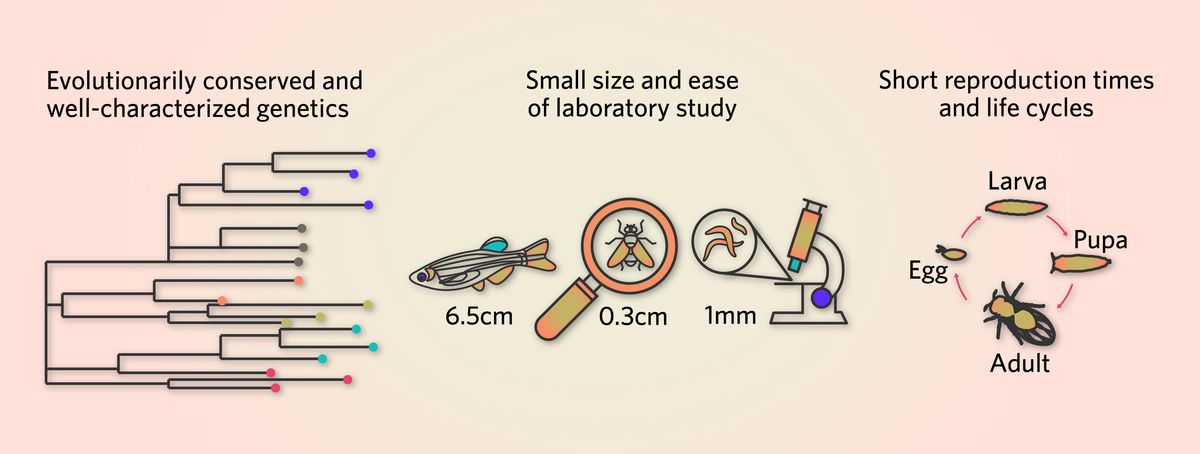Article reviewed by Tristan Long, PhD from Wilfrid Laurier University.
Stay up to date on the latest science with Brush Up Summaries.
What Is a Model Organism?
A model organism is a nonhuman species that scientists study to gain insight into biological and behavioral processes that are evolutionarily conserved between different living things.1 Model organisms often enable genetic and physiological discoveries, and allow researchers to investigate molecular, cellular, social, and environmental systems in a laboratory setting.2
Genetic similarity and common ancestry are key principles behind model organism research. All living things are related, from unicellular bacteria to complex multicellular plants and animals. This allows scientists to identify commonality in biological discoveries and extrapolate findings from one species to another.2 For example, early insect, plant, bacterial, and viral models of inheritance gave rise to the now common knowledge that DNA is the genetic material passed between generations, which provides the code or blueprint for life on Earth.2 Model organisms continue to reveal fundamental and universal biological processes, serving as research and teaching tools that shape scientific breakthroughs.2
What Makes a Good Model Organism?
Good model organisms often meet several criteria beyond evolutionary relatedness to humans, including ease of study and universal applicability across laboratories; available and stable genetic information that allows scientists to culture or rear organisms consistently without genetic drift; and available genomic and transcriptomic resources, including editing tools to modify, remove, or add target genes.1 Small size, short reproduction times and life cycles, and financial convenience also inform which organisms are well-suited for researchers seeking model systems.1

Several commonly studied model organisms are listed below.3
- Drosophila melanogaster (fruit flies)
- Caenorhabditis elegans (roundworms)
- Danio rerio (zebrafish)
- Mus musculus (mice)
- Xenopus sp. (clawed frogs)
- Arabidopsis thaliana (thale cress)
- Saccharomyces cerevisiae (budding yeast)
- Escherichia coli
These organisms are also successful models because of their versatility. “The best model species are ones that are not just two dimensional,” said Tristan Long, an evolutionary geneticist at Wilfrid Laurier University, who investigates a range of biological processes in fruit fly models, including sexual divergence, genetic variation, social and environmental influences on development, and bacterial infection susceptibility. “There are so many facets to [fruit fly] biology that we are never running out of ideas and never running out of projects,” Long said.
Animal Genetics and Selected Small Model Organisms
Small, genetically modifiable animal models such as D. melanogaster, C. elegans, and D. rerio have historically provided essential insights into genetic and cellular processes, and in some cases, more quickly and cost-effectively than rodent or large mammal models.4
Drosophila melanogaster
D. melanogaster, commonly known as the fruit fly, has been a model organism for more than a century, with evolutionary biologist Thomas Hunt Morgan at Columbia University performing some of the earliest investigations into animal genetics using fruit fly models in the early 1900s.5
“Most of the model organisms we have are vestiges of the past,” explained Long. “Jacques Monod famously said, what is true for E. coli is true for elephants, and I think the same thing is the case for fruit flies. They are not perfect analogs for everything out there, but they are practical to use, they are flexible in what we can use them for, and that really gives some useful insight.”
Since their origin as a practical genetic model, fruit flies have made their mark across physiological and behavioral research fields thanks to their small size, known life history traits, and plethora of available genetic tools.5 Scientists estimate that roughly 75% of human disease-causing genes have functional homologs in the fruit fly, which also contributes to their application in human health research.4 “Having those analogs and parallels is very useful,” said Long. “The actual nitty gritty details are always going to be different, depending on the life history and the genetic architecture of different species, but there is still an awful lot of universality.”
Caenorhabditis elegans
C. elegans are transparent and microscopic roundworms that are instrumental genetic models in neurobiology, aging, and development research. Initially championed as a potential model organism by biologist Sydney Brenner at the Medical Research Council Laboratory of Molecular Biology in the 1970s,6 the small size, rapid life cycle, amenability to genetic manipulation, and thoroughly mapped cellular and genetic processes of C. elegans contribute to its common use in research.4 Although C. elegans share fewer human physiological systems and gene homologs (roughly 65%) than fruit flies, they continue to provide invaluable insights into conserved molecular processes, and researchers turn to these tiny invertebrates for fast and financially efficient whole organism high throughput drug screening.4
Danio rerio
D. rerio, commonly referred to as the zebrafish, is a model organism that has been highly informative in vertebrate genetics studies. Building on her foundational work in fruit fly models, developmental biologist Christiane Nüsslein-Volhard at the Max Planck Institute for Developmental Biology transitioned her research focus to zebrafish in the 1990s to investigate embryonic development.7 These fish have large transparent embryos that mature externally and rapidly, facilitating vertebrate research and lowering laboratory infrastructure costs compared to mouse and rat models.4 Zebrafish also have human homologous organs such as the liver and kidney, and complete innate and adaptive immune systems, which is ideal for therapeutic research.4
Model Organism Research Milestones and Nobel Prize Recognitions
Major research milestones are often associated with well-established model organisms.1 For example, D. melanogaster, C. elegans, D. rerio, and A. thaliana models enabled major strides in developmental genetics; E. coli models helped scientists elucidate transcriptional regulation mechanisms; S. cerevisiae models allowed some of the earliest deciphering of the eukaryotic cell cycle; and mouse models have become staples in human physiology and disease research.1
Model organism research also forms the foundation for many Nobel Prize-recognized scientific breakthroughs.
Table: Examples of Nobel Prize-recognized breakthroughs supported by model organism research8
Model organism | Example contributions |
D. melanogaster | |
C. elegans | |
M. musculus |
This variety and success reflect the collaborative international research communities using model organisms today.3 For instance, fruit fly biologists frequently exchange knowledge, resources, and genetically characterized fly stocks. “There is a great amount of openness and a great amount of sharing,” said Long. “Because there is such a good community in the fruit fly world, we have access to all kinds of really great tools.” What began as convenient genetic research tools grew into beloved and insight-providing models that connect scientists from different research fields across the globe.5
- Bertile F, et al. Diversifying the concept of model organisms in the age of -omics. Commun Biol. 2023;6(1).
- Model organisms: Nature’s gift to disease research. Genetics. 2020;214(2):233-234.
- Model Organism Sharing Policy. US Department of Health and Human Services National Institutes of Health. Accessed June 14, 2024.
- Pandey UB, Nichols CD. Human disease models in Drosophila melanogaster and the role of the fly in therapeutic drug discovery. Pharmacol Rev. 2011;63(2):411-436.
- Cook KR, Parks AL. The international exchange of Drosophila melanogaster strains. RevSci Tech. 2022;41(1):82-90.
- Brenner S. The genetics of Caenorhabditis elegans. Genetics. 1974;77(1):71-94.
- Brown K. An interview with Christiane Nüsslein-Volhard. Development. 2017;144(21):3851-3854.
- All Nobel Prizes. The Nobel Prize. Accessed June 14, 2024.

